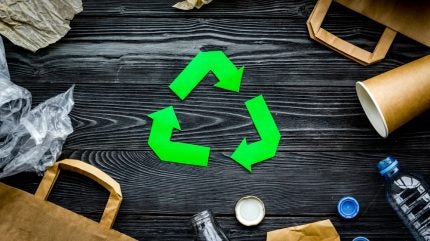
Moving 30% of grocery goods sold in the UK to reusable packaging could cut emissions and EPR costs by more than 90%, new research has claimed.
The report by consultancy GoUnpackaged and involving a panel featuring Tesco, Ocado and WRAP said the industry and government should “commit to a target” for reusable packaging in the UK.

Discover B2B Marketing That Performs
Combine business intelligence and editorial excellence to reach engaged professionals across 36 leading media platforms.
The study outlines a roadmap for building reusable packaging systems across the UK grocery retail sector to hit the 30% target by 2035.
According to the research, the target could be achieved by switching 18 “priority” categories of products to “around 30 standardised packaging types”. The study ranked the product areas in order of the highest cost savings: home-cooking products – including sauces, pasta and rice – was top, with the list also featuring alcohol, coffee, detergents, fruit and ready meals.
The report estimates hitting the 30% re-use target could cut packaging-related emissions by 95% and lead to an annual saving of £136m on the products under the scope of the UK’s extended producer responsibility, or EPR, rules. The saving amounts to a 94% reduction in EPR feeds per item switched to reuse, the study showed.
Campaigners argue that reuse systems could generate cost savings for retailers over time, compared with continually sourcing new single-use materials. At present, only 1-2% of consumer packaging in the UK is reusable.

US Tariffs are shifting - will you react or anticipate?
Don’t let policy changes catch you off guard. Stay proactive with real-time data and expert analysis.
By GlobalDataThe report suggests increasing this proportion to 10% by 2030 and then 30% by 2035.
To reach these targets, the researchers propose a combination of adapting regulation, infrastructure investment and incentives. These include standardising reusable packaging formats, introducing mandatory reporting requirements, and providing start-up funding for reuse pilots.
The organisations backing the report, which include packaging giant Amcor, logistics business CHEP and WWF, stress voluntary initiatives alone will not deliver the change needed.
“The modelling results show, for the first time, an evidenced view of reuse working at scale in the UK for grocery retail, enabling industry and government to make insightful decisions about how to move forwards to co-create the necessary transition to reuse in the UK,” a statement from the report’s advisory panel read.
However, the researchers admitted their modelling suggests the re-use push would need investment of £149m a year up to 2035. It suggested three ways to fund the investment: add to EPR fees; a mix of higher EPR fees and a tax on single-use items; a combination of increased EPR charges and government funding.
“Industry needs long-term policy certainty from the government to create a level playing field, allow long-term planning and investment, and create the right incentives to support the transition to reuse,” the report read.
Last month, PepsiCo announced changes to its targets on packaging.
The US food and drinks giant had been looking to “deliver 20% of all beverage servings through reusable models by 2030”, a target that no longer exists.
The company said it will focus on a wider goal for reusable, recyclable, or compostable (RRC) packaging by design. By 2030, PepsiCo is aiming for at least 97% of its packaging to be “RRC packaging by design … in our primary and secondary packaging in our key packaging markets”.
PepsiCo is aiming to cut its use of virgin plastic by 2% year-on-year on average through to 2030. The company’s previous target was for a 20% decrease “derived from non-renewable sources” by the same year.
The group’s goal for its use of recycled content stands at a reduction of at least 40% “by 2035 or sooner”. It had been targeting using 50% of recycled content by 2030.
In December, The Coca-Cola Company set out revised packaging targets.
The group now has two goals on packaging, set for 2035. One is an aim to use 35% to 40% (down from 50%) recycled material in “primary packaging”, which it says is plastic, glass and aluminium. Coca-Cola said it wants to increase its use of recycled plastic from 30% to 35%.
The other is to “ensure the collection of 70% to 75% of the equivalent number of bottles and cans introduced into the market annually”.
The new targets do not include an explicit goal for refillable or reusable packaging but Coca-Cola said it will “continue to invest in refillable packaging where infrastructure already exists”.
A spokesperson said: “We intend to continue to expand the use of refillable packaging in markets where the infrastructure is in place to support this important part of our portfolio and we tailor our refillable packaging approach by market, based on local conditions.”





